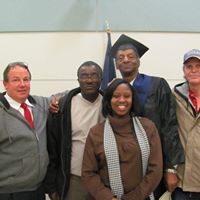Charles D Hodge
age ~48
from Cleveland, MN
Charles Hodge Phones & Addresses
- Cleveland, MN
- Mankato, MN
- Eden Prairie, MN
- Minnetonka, MN
- Aurora, IL
- Minneapolis, MN
Work
-
Company:Red team business consultingJul 2014
-
Position:Public and nonprofit consultant
Education
-
School / High School:Capella University- Minneapolis, MNJul 2011
-
Specialities:Masters of Nonprofit Management and Leadership in President
Resumes

Charles Hodge
view source
Charles Hodge
view source
Charles Hodge
view source
Charles Hodge
view source
Charles Hodge
view sourceLocation:
United States

Charles Hodge
view sourceLocation:
United States

Charles Hodge Gresham, OR
view sourceWork:
Red Team Business Consulting
Jul 2014 to 2000
Public and Nonprofit Consultant Maple Star Oregon
Portland, OR
Nov 2011 to Jul 2014
Director of Operations Maple Star Oregon
Portland, OR
Apr 2006 to Nov 2011
Director of Certification Maple Star Oregon
Portland, OR
Jan 2004 to Apr 2006
Family Care Coordinator Haag Home for Boys
Junction City, OR
Jul 1996 to Jan 2004
Treatment Manager
Jul 2014 to 2000
Public and Nonprofit Consultant Maple Star Oregon
Portland, OR
Nov 2011 to Jul 2014
Director of Operations Maple Star Oregon
Portland, OR
Apr 2006 to Nov 2011
Director of Certification Maple Star Oregon
Portland, OR
Jan 2004 to Apr 2006
Family Care Coordinator Haag Home for Boys
Junction City, OR
Jul 1996 to Jan 2004
Treatment Manager
Education:
Capella University
Minneapolis, MN
Jul 2011 to Mar 2013
Masters of Nonprofit Management and Leadership in President Northwest Christian University
Eugene, OR
Sep 1992 to Jun 1995
Bachelors of Science in Pastoral Ministry
Minneapolis, MN
Jul 2011 to Mar 2013
Masters of Nonprofit Management and Leadership in President Northwest Christian University
Eugene, OR
Sep 1992 to Jun 1995
Bachelors of Science in Pastoral Ministry
Medicine Doctors

Charles V. Hodge
view sourceSpecialties:
Pediatric Gastroenterology
Work:
Childrens Mercy South Specialty Clinic
5808 W 110 St, Leawood, KS 66211
9136968000 (phone), 9136968695 (fax)
Pediatric Gastroenterology Nutrition & Hepatology
2401 Gillham Rd, Kansas City, MO 64108
8162343016 (phone), 8162341553 (fax)
5808 W 110 St, Leawood, KS 66211
9136968000 (phone), 9136968695 (fax)
Pediatric Gastroenterology Nutrition & Hepatology
2401 Gillham Rd, Kansas City, MO 64108
8162343016 (phone), 8162341553 (fax)
Education:
Medical School
Temple University School of Medicine
Graduated: 1977
Temple University School of Medicine
Graduated: 1977
Procedures:
Upper Gastrointestinal Endoscopy
Conditions:
Acute Pancreatitis
Allergic Rhinitis
Celiac Disease
Constipation
Esophagitis
Allergic Rhinitis
Celiac Disease
Constipation
Esophagitis
Languages:
English
Spanish
Spanish
Description:
Dr. Hodge graduated from the Temple University School of Medicine in 1977. He works in Overland Park, KS and 1 other location and specializes in Pediatric Gastroenterology. Dr. Hodge is affiliated with Childrens Mercy Hospital and Childrens Mercy Hospital Kansas.

Charles H. Hodge
view sourceSpecialties:
Emergency Medicine
Work:
Kaiser Permanente Medical Group
1600 Eureka Rd, Roseville, CA 95661
9167844000 (phone), 9167463997 (fax)
1600 Eureka Rd, Roseville, CA 95661
9167844000 (phone), 9167463997 (fax)
Education:
Medical School
Rosalind Franklin University/ Chicago Medical School
Graduated: 1997
Rosalind Franklin University/ Chicago Medical School
Graduated: 1997
Languages:
English
Description:
Dr. Hodge graduated from the Rosalind Franklin University/ Chicago Medical School in 1997. He works in Roseville, CA and specializes in Emergency Medicine. Dr. Hodge is affiliated with Kaiser Permanente Medical Center - Roseville.
Isbn (Books And Publications)



What Is Darwinism?: And Other Writings on Science and Religion
view sourceAuthor
Charles Hodge
ISBN #
0801067928


Commentary on the Second Epistle to the Corinthians
view sourceAuthor
Charles Hodge
ISBN #
0802880320



Name / Title
Company / Classification
Phones & Addresses
Chairman of the Board
State University of New York Health Science Center at Syracuse
Children's Miracle Network · Medical Doctor's Office General Hospital · General Hospital · Ret Gifts/Novelties · Urologist · Whol Medical/Hospital Equipment · General Hospital Administrative Public Health Programs Executive Office · Medical Office
Children's Miracle Network · Medical Doctor's Office General Hospital · General Hospital · Ret Gifts/Novelties · Urologist · Whol Medical/Hospital Equipment · General Hospital Administrative Public Health Programs Executive Office · Medical Office
3154644416, 3154645540, 3154645480, 3154644713
Us Patents
-
Multi-Step Post Detergent Treatment Method
view source -
US Patent:6484734, Nov 26, 2002
-
Filed:Jul 14, 1999
-
Appl. No.:09/353706
-
Inventors:Terrence P. Everson - Eagan MN
Shaun P. Kennedy - North Oaks MN
Charles A. Hodge - Cottage Grove MN -
Assignee:Ecolab Inc. - St. Paul MN
-
International Classification:B08B 304
-
US Classification:134 252, 134 3, 134 41, 134 26, 134 29, 134 36, 510514, 510521, 510522, 510524
-
Abstract:Thus use of a post detergent step for removing aqueous residue from ware combined with a subsequent step using a potable rinse or a dilute solution of an aqueous food grade rinse aid to rinse alkaline washed ware provides significant advantages. The two step rinse method insures complete and sanitary cleaning of ware while permitting the use of different formulations in the post detergent step and the subsequent rinse step. Such process conditions permit the use of differing times and temperatures in the post detergent step and in the rinse step and permits the use of different formulations in the post detergent step and in the rinse step.
-
Automated Fragrance Application Apparatus And Method
view source -
US Patent:6584633, Jul 1, 2003
-
Filed:Dec 12, 2000
-
Appl. No.:09/735395
-
Inventors:Brian Chute - Inver Grove Heights MN
Charles A. Hodge - Cottage Grove MN
Richard J. Mehus - Richfield MN
Peter W. Rauen - Cottage Grove MN
Thomas L. Hennemann - Winston-Salem NC
William Crawford - Eden Prairie MN
Paul Mattia - Prior Lake MN -
Assignee:Ecolab Inc. - St. Paul MN
-
International Classification:D06B 102
-
US Classification:8158, 68 191, 68 20
-
Abstract:A method and apparatus provide for an automated fragrance dispenser for the application of a fragrance to dry fabrics during an industrial laundering process. In one embodiment, the fragrance dispenser is positioned outside the dryer, and preferably on the exit side of the steam tunnel in the laundering process. The fragrance dispenser includes a sensor for determining whether the garment passing on the conveyor is the type of garment to which the fragrance is to be applied, for example, a uniform shirt versus pants. The fragrance dispenser also includes a delivery system for applying the fragrance to selected garments. The delivery system also includes a timing device for dispensing the fragrance onto the garment for a controlled amount of time. In an alternative embodiment of the present invention, automated application of the fragrance to fabrics is provided in the dryer within the laundering process. The fragrance dispenser according to this embodiment includes a product media located in the air intake environment of the dryer, and a delivery system for applying the fragrance to the product media.
-
Multi-Step Post Detergent Treatment Method
view source -
US Patent:6694989, Feb 24, 2004
-
Filed:Oct 2, 2002
-
Appl. No.:10/263604
-
Inventors:Terrence P. Everson - Eagan MN
Shaun P. Kennedy - North Oaks MN
Charles A. Hodge - Cottage Grove MN -
Assignee:Ecolab Inc. - St. Paul MN
-
International Classification:B08B 304
-
US Classification:134 252, 134 26, 134 28, 134 29, 510514, 510521, 510522, 510524
-
Abstract:Thus use of a post detergent step for removing aqueous residue from ware combined with a subsequent step using a potable rinse or a dilute solution of an aqueous food grade rinse aid to rinse alkaline washed ware provides significant advantages. The two step rinse method insures complete and sanitary cleaning of ware while permitting the use of different formulations in the post detergent step and the subsequent rinse step. Such process conditions permit the use of differing times and temperatures in the post detergent step and in the rinse step and permits the use of different formulations in the post detergent step and in the rinse step.
-
Method And Apparatus For Dispensing Fragrances
view source -
US Patent:7543761, Jun 9, 2009
-
Filed:Jul 19, 2005
-
Appl. No.:11/184340
-
Inventors:Richard Jondall Mehus - Richfield MN, US
Charles Allen Hodge - Cottage Grove MN, US -
Assignee:Ecolab Inc. - Saint Paul MN
-
International Classification:A62C 5/02
A62C 13/62
A62C 13/66
A62C 31/00
A01G 27/00 -
US Classification:239 10, 239 69, 239303, 239305, 239328
-
Abstract:A method and apparatus dispenses first and second fragrances by utilizing a fog nozzle in a ductwork of a facility. The first fragrance is dispensed, at intervals, through the fog nozzle into the ductwork and the second fragrance is dispensed after the first fragrance is dispensed, wherein fragrance desensitivity is reduced.
-
Method And Apparatus For Dispensing A Use Solution
view source -
US Patent:7615122, Nov 10, 2009
-
Filed:Aug 18, 2005
-
Appl. No.:11/206618
-
Inventors:Richard J. Mehus - Richfield MN, US
Charles A. Hodge - Cottage Grove MN, US -
Assignee:Ecolab Inc. - St. Paul MN
-
International Classification:B08B 3/00
-
US Classification:134 36, 1341001, 134 992, 417182, 68 17 R, 68207, 137893, 137895, 22 1, 22133, 239310, 239410
-
Abstract:A method and apparatus provides for dispensing a liquid concentrate. The source pressure of a liquid diluent is changed by a boost pump () to bring the pressure of the diluent to an elevated pressure. The diluent then enters an aspirator assembly () wherein the concentrate and diluent are mixed to form a use solution. The dynamic pressure of the diluent entering the aspirator assembly () is sufficient so that the amount of concentrate delivered over time is more constant.
-
Concentration Monitor
view source -
US Patent:8012421, Sep 6, 2011
-
Filed:Jun 24, 2003
-
Appl. No.:10/602384
-
Inventors:Richard J. Mehus - Richfield MN, US
Charles A. Hodge - Cottage Grove MN, US
Quang Van Dao - Eden Prairie MN, US -
Assignee:Ecolab Inc. - St. Paul MA
-
International Classification:G01N 33/00
-
US Classification:422 8202, 422 50, 422 8201, 436149, 436150
-
Abstract:A concentration monitor for monitoring a concentration of a plurality of use solutions, each of the plurality of use solutions being, at least, a concentrate in a diluent, each of the plurality of use solutions having a resistivity which varies as a function of both temperature and an amount of the concentrate contained in a given amount of the diluent. A resistivity probe is adapted for use with at least one of the plurality of use solutions for taking a measurement related to the resistivity of the at least one of the plurality of use solutions. A temperature sensor is adapted for use with the at least one of the plurality of use solutions for taking a measurement related to the temperature of the at least one of the plurality of use solutions. A controller calculates the concentration of the at least one of the plurality of the use solutions based upon a predetermined algorithm using the resistivity and the temperature for the particular one of the at least one of the plurality of use solutions, the algorithm being based upon knowledge of the at least one of the plurality of use solutions being measured.
-
Concentration Monitor Method
view source -
US Patent:8187540, May 29, 2012
-
Filed:Jul 21, 2011
-
Appl. No.:13/188256
-
Inventors:Richard J. Mehus - Richfield MN, US
Charles A. Hodge - Cottage Grove MN, US
Quang Van Dao - Eden Prairie MN, US -
Assignee:Ecolab Inc. - St. Paul MN
-
International Classification:G01N 33/00
-
US Classification:422 8202, 436147, 436174
-
Abstract:A concentration monitor for monitoring a concentration of a plurality of use solutions, each of the plurality of use solutions being, at least, a concentrate in a diluent, each of the plurality of use solutions having a resistivity which varies as a function of both temperature and an amount of the concentrate contained in a given amount of the diluent. A resistivity probe is adapted for use with at least one of the plurality of use solutions for taking a measurement related to the resistivity of the at least one of the plurality of use solutions. A temperature sensor is adapted for use with the at least one of the plurality of use solutions for taking a measurement related to the temperature of the at least one of the plurality of use solutions. A controller calculates the concentration of the at least one of the plurality of the use solutions based upon a predetermined algorithm using the resistivity and the temperature for the particular one of the at least one of the plurality of use solutions, the algorithm being based upon knowledge of the at least one of the plurality of use solutions being measured.
-
Biodegradable Surfactant Blend
view source -
US Patent:8287658, Oct 16, 2012
-
Filed:Jun 2, 2009
-
Appl. No.:12/476594
-
Inventors:Altony J. Miralles - Woodbury MN, US
Amanda R. Blattner - Prior Lake MN, US
Charles A. Hodge - Cottage Grove MN, US -
Assignee:Ecolab USA Inc. - St. Paul MN
-
International Classification:B08B 3/04
C11D 1/72
C11D 3/22 -
US Classification:134 252, 134 253, 134 39, 134 42, 510238, 510239, 510240, 510245, 510360, 510421, 510474, 8137
-
Abstract:A degreasing composition is disclosed comprising an alkyl polyglucoside; and a nonionic surfactant having a carbon chain of Cor less. The nonionic surfactant comprises linear Calcohol ethoxylate. In an embodiment the linear Calcohol ethoxylate comprises from about 3 to about 6 moles of ethylene oxide. In another embodiment the alkyl polyglucoside and the alcohol ethoxylate comprise an active ratio of from about 3:1 to about 1:1 in the composition. The composition of the invention is useful in formulating a laundry detergent, a hard surface cleaner, an automatic dishwashing detergent, a hand dishwashing detergent, an oven cleaner, hand soap, or an automotive detergent.
Plaxo

Charles Hodges
view sourceMidland, TexasNormal, but sometimes a bit strange.

Charles Hodge
view sourceRoswell, GA

Charles Hodge
view sourceDallas, TX

Charles Hodge
view sourceCox Communications

Charles Hodges
view sourceCAPSTRAT
Classmates

Charles Hodge
view sourceSchools:
Laurel Park High School Martinsville VA 1981-1985
Community:
Edwanda Valentine, Charlesetta Smallwood, Debra Boswell, Steven Giles

Charles Hodge
view sourceSchools:
Avondale High School Avondale Estates GA 1975-1979
Community:
Reena Caldwell, Sherryl Cox

Charles Hodge
view sourceSchools:
Bible Methodist Christian School Pell City AL 1990-1994
Community:
Debra Baxter

Charles Hodge
view sourceSchools:
Waite High School Toledo OH 1982-1986

Charles Hodge
view sourceSchools:
Robert E. Lee High School Staunton VA 1964-1968

Charles Hodge
view sourceSchools:
Fox Chapel Middle School Spring Hill FL 1997-2001
Community:
Jennifer Schwed, Gina Smith, Michael Gartenberg

Charles Hodge
view sourceSchools:
Farmerville High School Farmerville LA 1969-1973
Community:
Jimmy Craighead, Mitchell Caldwell, Rodriques Hendricks

Charles Hodge
view sourceSchools:
West Hardin High School Stephensburg KY 1970-1974
Community:
John Perry, Shannon Reeves, Cathy Coates, Jennifer Clark
Youtube
Myspace
Googleplus

Charles Hodge
Work:
Ericsson - Central Office Tech
About:
I am the Moose, I enjoy sharing good times, good food, and good beer with good people.
Tagline:
Life is too short to drink cheap beer

Charles Hodge

Charles Hodge

Charles Hodge

Charles Hodge

Charles Hodge

Charles Hodge

Charles Hodge

Charles Hodge
view source
Charles Hodge
view source
Charles Hodge
view source
Charles Hodge
view source
Charles Hodge
view source
Charles Hodge
view source
Charles Hodge
view source
Charles Hodge
view sourceFlickr
Get Report for Charles D Hodge from Cleveland, MN, age ~48













